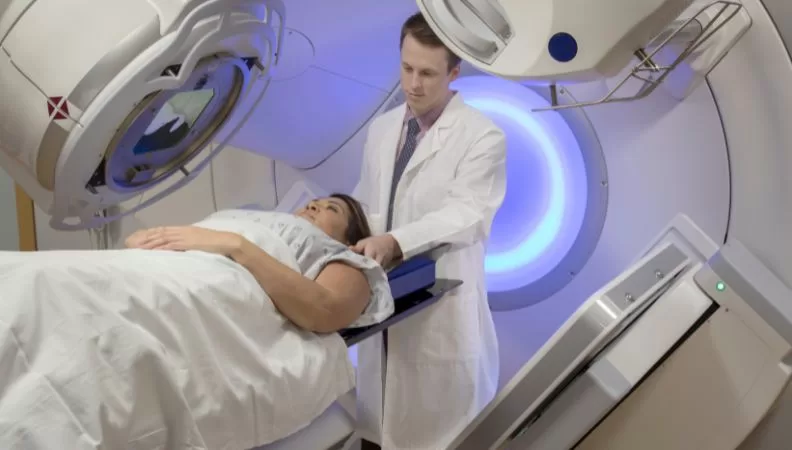Proton Therapy – A Breakthrough in Cancer Radiotherapy
Cancer continues to be one of the critical health problems in the world, affecting millions of people every year. Conventional radiation therapy is a successful therapy, but it has shortcomings including damage to the normal tissues and significant side effects. Enter proton therapy—a revolutionary advancement in cancer radiotherapy that offers greater precision, reduced toxicity, and improved patient outcomes.
This article explores how proton therapy works, its advantages over conventional radiation therapy, the types of cancers it treats, technological innovations, and what the future holds for this groundbreaking treatment.
Understanding Proton Therapy: What is Proton Therapy?
Proton therapy is a radiotherapy that uses protons instead of X-rays to kill cancer cells. In contrast to the conventional photon-based radiation, which emits energy all over the body, proton beams focus the radiation only on the tumor minimizing the damage made to the vicinity of healthy tissues.
How It Works: –
- A particle accelerator [called cyclotron or synchrotron] brings the protons at high velocity.
- Protons are focused on the tumor via very accurate imaging methods.
- They deliver energy precisely at the tumor location, terminating after the target, not at the periphery of the body.
- Because they are able to direct the treatment of cancer cells with greater specificity proton therapy is a revolution in contemporary oncology.
How Is Proton Therapy Different from Traditional Radiation?
- Energy Delivery Deposits most energy at the tumor, which continues through the body and affects healthy tissue.
- Side Effects Lower risk of damage to surrounding organs Higher risk due to radiation exposure.
- Precision Highly targeted Less precise
- Suitability for children Safer – as it has long-term effects Greater risk of psycho-developmental problems.
Advantages of Proton Therapy Over Conventional Radiation
- Greater Precision and Effectiveness
- Proton therapy is accurately confined to the tumor, sparing healthy tissues.
- This is particularly useful for the tumor located in an area close to the vital organs (e.g., brain, spinal cord, lung).
Reduced Side Effects and Complications
Reduced injury to adjacent organs implies fewer side effects (eg, nausea, fatigue, secondary cancer).
Patients recover faster with fewer post-treatment complications.
Ideal for Pediatric Cancer Patients
- Because children’s tissues are still immature, conventional radiation can lead to physical deformities and secondary malignancies.
- Proton therapy provides a safer option with less long-term side effects.
Higher Dose Delivery with Lower Risk
Using proton beams the oncologists can therefore give a bigger radiation dose to the tumor, without adding a higher risk of toxicity. This leads to better tumor control rates with less damage to normal tissues.
Increased Survival Rates with Proton Therapy
Evidence of the survival-enhancing effects, by virtue of improving hard-to-treat cancers, such as those of the brain and the head and neck, also indicates that proton therapy is superior to conventional ion therapy.
Types of Cancers Treated with Proton Therapy
- Proton therapy is especially useful for tumors that are intractable, or tumors proximate to critical structures.
- Common Cancers Treated with Proton Therapy
- Brain and Spinal Cord Tumors Safeguard fragile nerve tissues and minimize cognitive side effects.
- Head and Neck Cancers Minimize damage to salivary glands, reducing dry mouth and difficulty swallowing.
- Lung Cancer Lowers the risk of damaging lung tissue and the heart.
- Prostate Cancer Reduces radiation exposure to the bladder and rectum.
- Breast Cancer – Very useful for left-sided breast cancer, sparing radiation to the heart.
- Pediatric Cancers Ideal for children, minimizing risks of secondary cancers and developmental issues.
Technological Innovations in Proton Therapy
Development in proton therapy technology has increased its efficiency, reduced its cost, and made it more available.
Pencil Beam Scanning (PBS)
The most advanced form of proton therapy.
Employs a thin high-energy proton beam to “paint” the tumor in layers and thus enhances accuracy.
Image-Guided Proton Therapy (IGPT)
Compounds to specifically translate real-time imaging with proton therapy to enable real-time modifications to achieve accuracy.
FLASH Proton Therapy – The Future of Cancer Treatment
A novel experimental method providing ultra-high radiation doses in seconds.
Promising in the removal of tumors with reduced side effects still.
Challenges and Limitations of Proton Therapy
Although proton therapy is a sensational breakthrough, there are still challenges in its wider availability.
High Costs:- Proton therapy centers are expensive to establish due to their large infrastructure (e.g., cyclotrons), which elevates treatment price.
However, costs are decreasing as technology advances.
Limited Availability: Proton therapy facilities exist globally with less than 150 proton centers available, mainly located in the developed world.
Increasing access to low-income regions remains a challenge.
Insurance and Coverage Issues:- Since proton therapy is not fully covered by most insurance companies, there is a lack of long-term comparative studies to justify the coverage.
Patients are frequently also required to advocate for insurance or to undergo traditional radiation.
Pediatric Cancer Survivor: Lily’s Story
A 6-year-old patient with brain cancer, Lily, received proton therapy rather than conventional radiation.
She avoided cognitive side effects and developmental issues.
Today, she is cancer-free and leading a normal childhood.
Proton Therapy for Prostate Cancer – John’s Experience
As a 60-year-old prostate cancer patient, John selected proton therapy.
Avoided usual radiation side effects, such as urinary incontinence and bowel disturbances.
His treatment resulted in complete remission with minimal side effects.
The Future of Proton Therapy
The following years will address significant advances in proton therapy:-
More Proton Centers Worldwide Expansion into developing nations will improve access.
AI and Machine Learning Advanced algorithms will enhance treatment planning and personalization.
Cost Reduction Newer, more compact proton therapy machines are making treatment more affordable.
FLASH Proton Therapy If clinical trials succeed, FLASH therapy could replace conventional radiation in the future.
Conclusion
Proton therapy has changed cancer radiotherapy by providing the potential for increased accuracy, fewer side effects, and increased survival. With increasing technological development and increased access, it becomes possible for cancer to see the standard treatment through a major technological advancement. Although there are still challenges, research, and innovation continue to lead the way to a world where proton therapy is accessible to every cancer patient worldwide.



